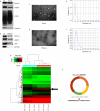Nomograms incorporating hsa_circ_0029325 highly expressed in exosomes of hepatocellular carcinoma predict the postoperative outcomes
- PMID: 38836972
- PMCID: PMC11153441
- DOI: 10.1007/s12672-024-01060-7
Nomograms incorporating hsa_circ_0029325 highly expressed in exosomes of hepatocellular carcinoma predict the postoperative outcomes
Abstract
Background: Liquid biopsies, for example, exosomal circular RNA (circRNA) can be used to assess potential predictive markers for hepatocellular carcinoma (HCC) in patients after curative resection. This study aimed to search for effective prognostic biomarkers for HCC in patients after surgical resection based on exosomal circRNA expression profiles. We developed two nomograms incorporating circRNAs to predict the postoperative recurrence-free survival (RFS) and overall survival (OS) of HCC patients.
Method: Plasma exosomes isolated from HCC patients and healthy individuals were used for circRNA microarray analysis to explore differentially expressed circRNAs. Pearson correlation analysis was used to evaluate the correlation between circRNAs and clinicopathological features. Cox regression analysis was used to explore the correlation between circRNA and postoperative survival time as well as recurrence time. A nomogram based on circRNA and clinicopathological characteristics was established and further evaluated to predict prognosis and recurrence.
Result: Among 60 significantly upregulated circRNAs and 25 downregulated circRNAs, hsa_circ_0029325 was selected to verify its power for predicting HCC outcomes. The high expression level of exosomal hsa_circ_0029325 was significantly correlated with OS (P = 0.001, HR = 2.04, 95% CI 1.41-3.32) and RFS (P = 0.009, HR = 1.62, 95% CI 1.14-2.30). Among 273 HCC patients, multivariate regression analysis showed that hsa_circ_0029325 (HR = 1.96, 95% CI 1.21-3.18), tumor size (HR = 2.11, 95% CI 1.33-3.32), clinical staging (HR = 2.31, 95% CI 1.54-3.48), and tumor thrombus (HR = 1.74, 95% CI 1.12-2.7) were independent risk factors for poor prognosis in HCC patients after radical resection. These independent predictors of prognosis were incorporated into the two nomograms. The AUCs under the 1-year, 3-year, and 5-year survival and recurrence curves of the OS and RFS nomograms were 0.755, 0.749, and 0.742 and 0.702, 0.685, and 0.642, respectively. The C-index, calibration curves, and clinical decision curves showed that the two prediction models had good predictive performance. These results were verified in the validation cohort with 90 HCC patients.
Conclusion: Our study established two reliable nomograms for predicting recurrence and prognosis in HCC patients. We also show that it is feasible to screen potential predictive markers for HCC after curative resection through exosomal circRNA expression profile analysis.
Keywords: Circular RNA; Exosomes; Hepatocellular carcinoma; Nomogram; Recurrence.
© 2024. The Author(s).
Conflict of interest statement
The authors are accountable for all aspects of the work in ensuring that questions related to the accuracy or integrity of any part of the work are appropriately investigated and resolved. No potential conflict of interests. The study was conducted in accordance with the Declaration of Helsinki (as revised in 2013). This study was approved by the First Affiliated Hospital of Chongqing Medical University (ID: 2023-161), and informed consent was obtained from all individual participants.
Figures






Similar articles
-
Nomograms Incorporating the CNLC Staging System Predict the Outcome of Hepatocellular Carcinoma After Curative Resection.Front Oncol. 2022 Jan 21;11:755920. doi: 10.3389/fonc.2021.755920. eCollection 2021. Front Oncol. 2022. PMID: 35127471 Free PMC article.
-
Novel Models Predict Postsurgical Recurrence and Overall Survival for Patients with Hepatitis B Virus-Related Solitary Hepatocellular Carcinoma ≤10 cm and Without Portal Venous Tumor Thrombus.Oncologist. 2020 Oct;25(10):e1552-e1561. doi: 10.1634/theoncologist.2019-0766. Epub 2020 Aug 6. Oncologist. 2020. PMID: 32663354 Free PMC article.
-
[Circular RNA hsa_circ_0006834 is a potential prognostic biomarker for hepatocellular carcinoma].Nan Fang Yi Ke Da Xue Xue Bao. 2023 Nov 20;43(11):1850-1856. doi: 10.12122/j.issn.1673-4254.2023.11.03. Nan Fang Yi Ke Da Xue Xue Bao. 2023. PMID: 38081601 Free PMC article. Chinese.
-
Novel potential tumor biomarkers: Circular RNAs and exosomal circular RNAs in gastrointestinal malignancies.J Clin Lab Anal. 2020 Jul;34(7):e23359. doi: 10.1002/jcla.23359. Epub 2020 May 17. J Clin Lab Anal. 2020. PMID: 32419229 Free PMC article. Review.
-
Circular RNAs are Potential Prognostic Markers of Head and Neck Squamous Cell Carcinoma: Findings of a Meta-Analysis Study.Front Oncol. 2022 Feb 28;12:782439. doi: 10.3389/fonc.2022.782439. eCollection 2022. Front Oncol. 2022. PMID: 35296016 Free PMC article.
Cited by
-
Extracellular Vesicles As a Source of Biomarkers for Cancer Diagnosis.Acta Naturae. 2025 Apr-Jun;17(2):28-40. doi: 10.32607/actanaturae.27591. Acta Naturae. 2025. PMID: 40771849 Free PMC article.
References
Grants and funding
LinkOut - more resources
Full Text Sources
